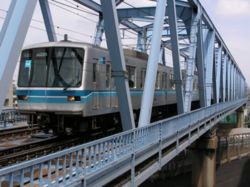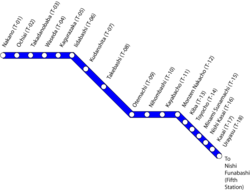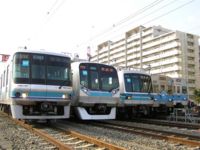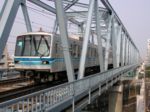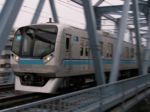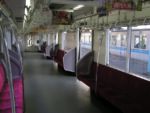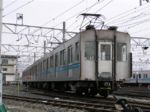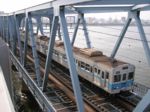Tokyo Metro Tōzai Line
The Tokyo Metro Tozai Line (東京地下鉄東西線 Tōkyō Chikatetsu Tōzai-sen?) is a subway line. Part of the Tokyo Metro system, it connects Nakano Station in Nakano Ward, Tokyo, Japan and Nishi-funabashi Station in the city of Funabashi, Chiba Prefecture. On maps, its color is light blue; stations on the Tozai Line carry the letter T followed by a two-digit number.
The Tozai Line is the second most-ridden subway line in Japan (after the Midosuji Line in Osaka), and according to a 2005 study, is the country's most crowded during rush hours, when it operates at nearly twice its design capacity on average. Women-only cars, designed to prevent chikan, were introduced on the line during morning rush hours starting on November 20, 2006.
Contents
Facts
- Length: 30.8 km
- Gauge: 1067 mm
- Number of stations: 23 (including ends)
- Multiple-track section: Entire line
- Electric supply: 1500 V DC
- Block system: Automatic (Eidan CW-ATC)
- Underground segment: Nakano Station–Minami Sunamachi Station
Development
The Tozai Line was planned by a Ministry of Transportation review committee in 1962 and named Line 5. Its name literally means "East-West Line," and it was primarily planned to relieve traffic on the busy Sobu Main Line between Tokyo and Urayasu, as well as provide a straight crosstown connection through north-central Tokyo. Although this corridor is now served by the Toei Shinjuku Line and JR Keiyo Line as well, the Tozai Line continues to operate beyond capacity due to its convenience to other lines, as well as to growing condominium developments in eastern Tokyo.
The Takadanobaba-Kudanshita section of the line opened in 1964, and the remainder opened in stages until its completion in 1969. Through service with Japan National Railways began in 1969, connecting the local sections of the Chuo and Sobu lines.
The Toyo Rapid Railway, effectively an eastward extension of the Tozai Line, opened in 1996.
Stations
The Tozai Line is currently the only subway line in Tokyo that has at least one direct connection to every other subway line. The Fukutoshin Line, presently under construction, will cross the Tozai Line but does not have a direct connection to it, with Tozai Line Takadanobaba Station about 500m away from Fukutoshin Line Nishi-Waseda Station.
Rolling stock
- Rolling stock of Tozai Line is 20m 4doors long sheet car.
- Maxim speed of business on Tozai line : 100km/h
- M = motor car : have 4 motors
- T = trailer car : have no moters
Tokyo Metro 05 series
- 10-car trains x 43
It has many types. After 05-125F which were changed their face, called "New05" too. 05-114F to 05-118F have wide doors.
Master controller have deadman system (If driver separate master controller, brakes work). Partition of driver's cab and passenger room have 3 windows. On Tozai Line, usually 2 windows were closed by curtain but other is clear so passenger can look prospect even on subway.
Date
| 05-101 to 113F | 05-114F | 05-115 to 118F | 05-119 to 124F | 05-125 to 133F | 05-134 to 139F | 05-140 to 143F | |
|---|---|---|---|---|---|---|---|
| Maxim speed of trains | 110km/h | 120km/h | |||||
| Acceleration / Slowdown | Acceleration 3.3km/h/s / Slowdown 3.5km/h/s (emergency 5.0km/h/s) | ||||||
| Face style | square lights, no skirt | circle lights, have a skirt | |||||
| Headlights | shield beam | HID | |||||
| Destination indication | curtain | 3 colors LED | |||||
| Guidance of LED inside of car | 8/car | 4/car | |||||
| Control system | Chopper | GTO-VVVF | Chopper | IGBT-VVVF | |||
| MT ratio | 5M5T | 4M6T | 5M5T | 4M6T | 5M5T | ||
| Motor power (among one moter) | 160kW | 200kW | 160kW | 205kW | 165kW | ||
| Train power | 3,200kW | 3,280kW | 3,300kW | ||||
| Gear ratio | 5.73(86:15) | 7.79(109:14) | 5.73(86:15) | 7.79(109:14) | 6.21(87:14) | ||
| Pantograph | lozenge 5 | lozenge 4 | lozenge 5 | lozenge 4 | single arm 5※ | single arm 3 | |
| Wide of door | 1.3m | 1.8m | 1.3m | ||||
| Driver's cab | Two handle | One handle | |||||
| Seat placement (middle car and no space) | 3-7-7-7-3 | 2-6-6-6-2 | 4-6-7-6-4 | 3-7-7-7-3 | |||
- ※ : 05-135 to 139F use 3 pantographs (other pantographs are no used).
Formation
- 05-101 to 113F
- Made in 1988 to 1991.
- From 05-104F glass of face is slightly extend.
- 05-114F
- Made in 1991.
- Wide door car.
- Test car of VVVF.
- 05-115 to 118F
- Made in 1992.
- Wide door car.
- Running system is return to 101~113F.
- 05-119 to 124F
- Made in 1993 to 1994.
- Running system is almost same as series 06 (used on Chiyoda Line) and series 07.
- Fenestration is unevenness.
- 05-124F is aluminum recycle car.
- 05-125 to 133F
- Made in 1999 to 2001.
- Design is completely changed.
- Performance is almost same as 119~124F.
- 05-134 to 139F
- Made in 2002 to 2003.
- Running system is almost same as series 08 (used on Hanzomon Line). So rapidity performance is up.
- Fenestration iscommon again.
- 05-140 to 143F
- Made in 2004.
- Running system is almost same as 134~139F. But use pure electric brake.
- Adopt A-Train of Hitachi so method of body molding is changed.
Tokyo Metro 07 series
Details please show date of 07.
- 10-car
- It from Yurakucho Line 2006
- Motor power : 205kW 4M6T
- Maxim speed of trains : 110km/h
Tokyo Metro 5000 series
- 10-car
- Until March 2007
- Motor power : 100kW 8M2T
Run from other rail way
- Toyo Rapid 2000 series 10-car x11
- Basic designs follow as 05-140F to 05-143F.
- Motor power : 165kW 5M5T
- Maxim speed of trains : 120km/h
- JR East E231-800 series 10-car x7
- Motor power : 95kW 6M4T
- Maxim speed of trains : 120km/h
Mass transit in Tokyo | |
|---|---|
| Metro lines (Subway) | Chiyoda · Fukutoshin · Ginza · Hanzōmon · Hibiya · Marunouchi · Namboku · Tōzai · Yūrakuchō |
| Toei lines | Subway: Asakusa · Mita · Ōedo · Shinjuku Streetcar: Arakawa |
| JR lines | Yamanote · Chūō · Chūō-Sōbu · Jōban · Keihin-Tōhoku · Keiyō · Saikyō · Shōnan-Shinjuku · Sōbu · Tōkaidō · Yokosuka |
| Other networks | Keikyū · Keiō · Keisei · Nippori-Toneri · Odakyū · Seibu · Tōbu · Tokyo Monorail · Tōkyū · TWR · TX · Yurikamome |
| Around Tokyo | Chiba Monorail · Enoden · Hokusō · Saitama Rapid · Saitama New Urban · Shin-Keisei · Shōnan Monorail · Sōtetsu · Tama Monorail · Tōyō Rapid · Yokohama MM · Yokohama Subway |
| Terminals | Asakusa · Ikebukuro · Kita-Senju · Oshiage · Shibuya · Shinagawa · Shinjuku · Tōkyō · Ueno |
| Miscellaneous | PASMO · Passnet · Suica · Transportation in Greater Tokyo |
